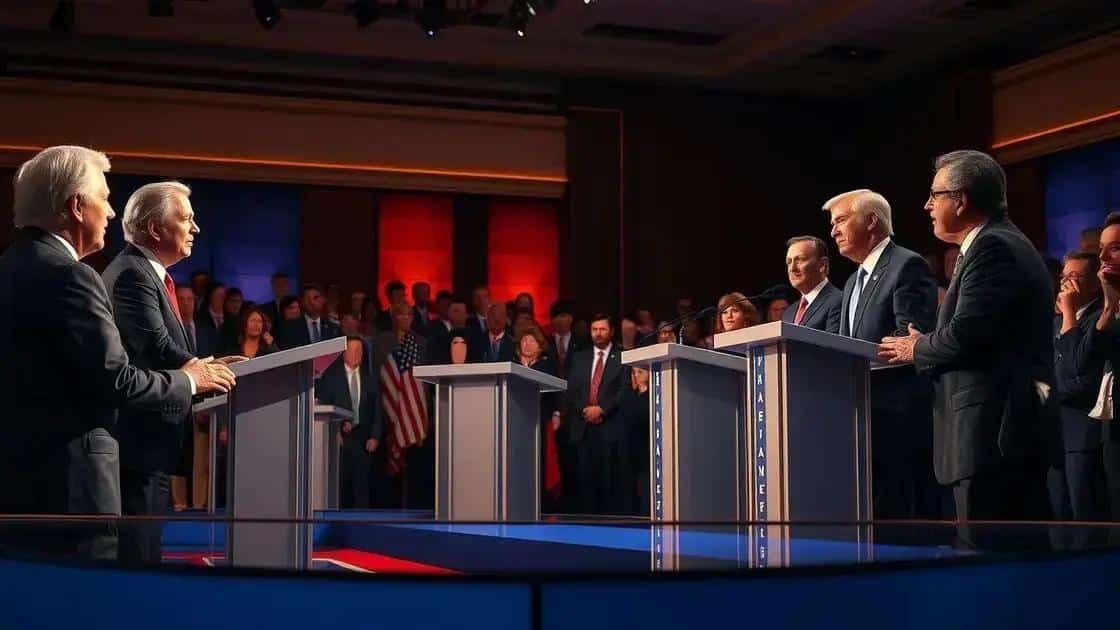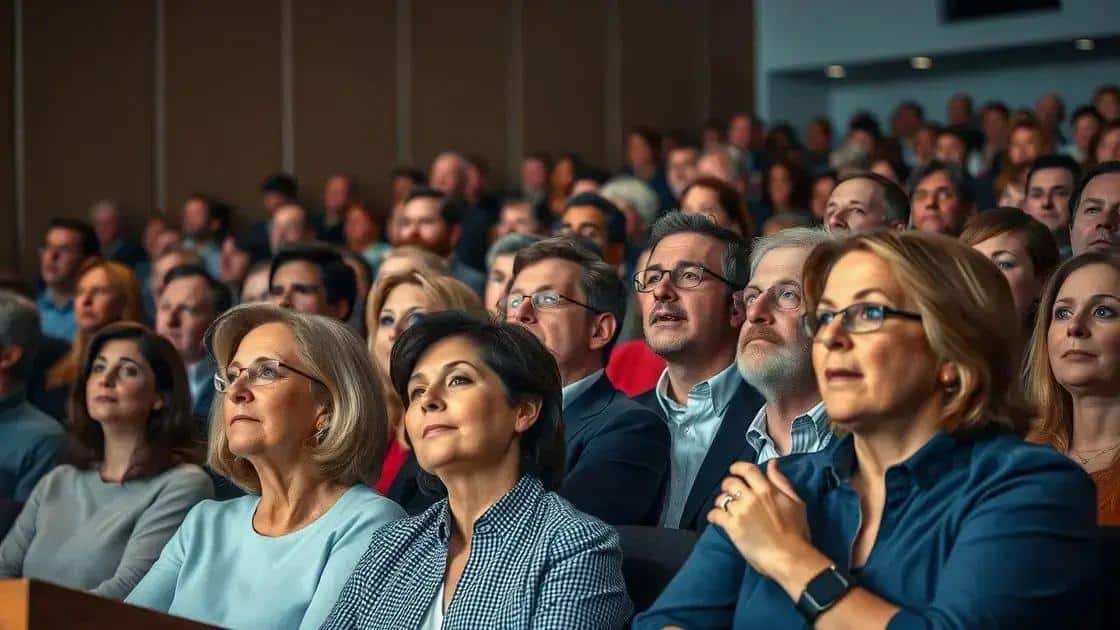People presidential debate coverage: what to expect

People presidential debate coverage examines key issues, media influence, and public opinion, impacting voter perception and candidate strategies during elections.
People presidential debate coverage plays a crucial role in shaping our understanding of elections. As debates unfold, they not only highlight candidate positions but also influence public perception. Have you ever wondered how these events affect your voting decisions?
Key issues in the upcoming presidential debates
As the election season heats up, understanding the key issues in the upcoming presidential debates becomes essential for every voter. These debates serve as a platform for candidates to showcase their views and engage with the public, emphasizing topics that matter most to citizens.
Understanding Major Topics
Voters can expect discussions around significant issues, including:
- Healthcare: Candidates will likely present their plans to improve healthcare access and affordability.
- Economy: The economic recovery will be a hot topic, focusing on job creation and inflation control.
- Climate Change: Debates will highlight strategies for environmental protection and future sustainability.
- Social Justice: Issues regarding equality and justice will spark conversations about policy changes needed.
Each of these topics resonates differently with various segments of the population. For instance, younger voters may prioritize climate change initiatives while older voters might be more concerned with healthcare solutions. Candidates must tailor their messages to connect effectively with these audiences.
Impact of Public Opinion
Another vital aspect of these debates is how public opinion shapes the narrative. Polls often influence candidates as they prepare and respond during debates. If a particular issue is trending, you can be sure it will be addressed.
The dynamic between candidates and their responses to public concerns adds an exciting layer to each debate. Moreover, social media platforms amplify discussions, allowing voters to interact and express their opinions in real time, making them feel more engaged in the political process.
In conclusion, being aware of the key issues in the upcoming presidential debates is crucial for voters. This knowledge not only helps in making informed decisions but also fosters a deeper understanding of the candidates’ positions on matters that impact our lives.
How media transforms debate coverage
The role of media in shaping how we perceive debates cannot be overstated. Understanding how media transforms debate coverage helps us navigate the electoral landscape. From traditional broadcast methods to social media platforms, the way information is presented and consumed shapes public opinion significantly.
Traditional Media’s Influence
Television networks have historically dominated debate broadcasts. These platforms often highlight key moments, creating clips that circulate widely. This ability to distill complex discussions into short, impactful segments influences what topics resonate most with audiences.
- Selective Highlighting: Media outlets may choose specific clips to air, which can skew public perception.
- Commentary: Analysts dissect performances, offering opinions that can shape viewer impressions.
- Fact-Checking: Many organizations monitor factual claims made during debates, informing audiences.
Additionally, the portrayal of candidates often hinges on how the media frames their arguments. For example, a well-delivered line can turn a candidate into a debate star overnight. Conversely, a misstep can lead to significant backlash.
The Rise of Social Media
In recent years, social media has emerged as a powerful player in debate coverage. Platforms like Twitter and Facebook allow real-time reactions and discussions, turning viewers into participants. This shift changes the dynamics of how candidates communicate with their audiences.
With hashtags trending during debates, particular issues gain visibility. Voters share thoughts, memes, and clips, which can amplify certain narratives. The immediacy of social media creates a feedback loop where candidates must adapt quickly to public sentiment.
Moreover, influencers and ordinary citizens alike can sway opinions, contributing to a more democratic discourse. With so many voices in the conversation, the traditional media narrative faces challenges in maintaining control.
Understanding how media transforms debate coverage reveals the complexities at play in modern elections. As voters, being aware of these dynamics allows us to critically analyze the information presented to us.
The role of public opinion during debates

Public opinion plays a crucial role in shaping the dynamics of political debates. Understanding the role of public opinion during debates helps us recognize its impact on candidates and their messaging. This influence can be seen in how candidates prepare, respond, and adapt their strategies based on audience reactions.
Shaping Candidate Strategies
Candidates often gauge public sentiment through polls and social media feedback before and after debates. Knowing what issues resonate with voters allows them to tailor their arguments effectively.
- Focus Groups: Many campaigns use focus groups to test messages before the debates.
- Real-Time Reaction: Candidates adjust their responses based on audience reactions during the debate.
- Polling Data: Post-debate polls can signal which candidates performed well or poorly.
By examining public opinion, candidates can highlight their strengths while addressing concerns raised by voters. This adaptability can significantly affect their chances of winning support.
Media Amplification of Public Sentiment
The media also plays a pivotal role in shaping public perception of debates. News coverage, social media, and online discussions can amplify certain narratives. For instance, a standout moment or a blunder by a candidate can dominate media discussions for days.
The way the media frames these moments can influence what the public remembers about a candidate’s performance. As such, candidates must be aware that every word matters in a debate setting.
Furthermore, social media platforms allow voters to express their opinions instantaneously. This interaction creates an environment where public sentiment can shift rapidly, impacting candidates’ images and strategies. When many people share similar sentiments online, it often bleeds into mainstream media coverage, further shaping the narrative.
Ultimately, understanding the role of public opinion during debates illuminates the intricate dance between candidates and voters, showing how perceptions can shift and evolve in real-time.
Analyzing candidate performances: what matters
Analyzing candidate performances during debates is essential for voters seeking to make informed choices. Understanding what matters in these evaluations helps everyone engage with the political process more critically. Key aspects often highlight how candidates communicate their ideas and connect with the audience.
Key Criteria for Performance
Several factors contribute to how well a candidate performs in a debate. These include:
- Clarity of Message: Candidates should communicate their positions clearly to avoid confusion.
- Body Language: Nonverbal cues can convey confidence and openness. Voters often interpret these signals instinctively.
- Fact-Based Responses: Providing accurate information strengthens a candidate’s credibility during the debate.
- Engagement with Opponents: How candidates respond to challenges from opponents can set them apart. Strong, respectful exchanges often reflect strength and poise.
When voters analyze candidates using these criteria, they gain a more comprehensive understanding of each person’s strengths and weaknesses.
Impact of Audience Reactions
Audience reactions play a significant role in debates. Candidates can gauge their effectiveness by observing how the crowd responds. Positive reactions, such as applause or laughter, often signal that the candidate is resonating with viewers. In contrast, silence or negative reactions can indicate that a point did not land well.
This live feedback loop can affect candidates’ strategies. If they sense a lack of connection, they might adjust their approach on the fly, trying different messages or tactics to regain audience interest.
Moreover, social media platforms become another arena for real-time analysis. Comments, tweets, and shares during or after the debate provide insights into public perception. This rapid exchange of thoughts allows voters to engage with the debate beyond traditional viewing.
Ultimately, the process of analyzing candidate performances goes beyond mere numbers or polls. It involves a nuanced understanding of how candidates communicate, connect, and engage with the public and their opponents.
Social media’s impact on debate discussions
Social media has dramatically changed the landscape of debate discussions. Understanding social media’s impact on debate discussions can provide insights into how political messages spread and resonate with audiences. Platforms like Twitter, Facebook, and Instagram enable immediate interactions, making political discourse more dynamic and accessible.
Real-Time Engagement
One of the most significant effects of social media is the ability of viewers to engage in real-time. During debates, users tweet or post reactions that can influence the overall conversation. This instant feedback loop allows audiences to express opinions about candidates’ performances as they happen.
- Hashtags: Trending hashtags during debates create a collective dialogue, uniting viewers around common themes.
- Memes: Humorous content often spreads quickly, highlighting candidates’ remarks or fails, influencing public perception.
- Shareability: Clips of standout moments are easily shared, amplifying messages beyond the original broadcast.
This real-time interaction not only shapes the narrative but also pressures candidates to respond to public sentiment quickly. If a candidate receives praise or criticism on social media, they may adjust their messaging in subsequent debates or public appearances.
Shaping Voter Perception
Social media also plays a crucial role in shaping voter perception. The content that circulates online can influence how people interpret what they see during a debate. For example, a candidate’s statement might be taken out of context and interpreted differently depending on the framing it receives.
Moreover, echo chambers can form on social media platforms, where users are exposed primarily to content that reinforces their existing beliefs. This phenomenon can skew the public’s understanding of candidates’ positions and performance, making critical evaluation challenging.
The interactive nature of social media means that information spreads rapidly, and its influence can persist long after a debate concludes. Candidates must be aware of this new reality and carefully consider how their words will be perceived online.
Indeed, social media’s impact on debate discussions illustrates the power of digital communication in shaping political narratives and voter engagement.
FAQ – Frequently Asked Questions about Presidential Debate Coverage
How does public opinion influence debates?
Public opinion can affect how candidates formulate their responses and adjust their strategies based on audience reactions.
What role does social media play during debates?
Social media allows real-time engagement and amplifies messages, shaping the narrative and public perception of the candidates.
What key factors should voters consider when analyzing candidate performances?
Voters should focus on clarity of message, body language, fact-based responses, and how candidates engage with their opponents.
How can media coverage affect voter perception after a debate?
Media coverage can frame the narrative around a candidate’s performance, potentially swaying public opinion in the days following the debate.






